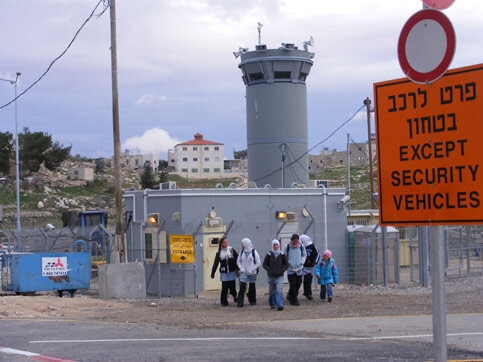The Electronic Intifada 11 March 2008

Schoolchildren from Nu’man must pass through the checkpoint to go to and from school each day. (Kareem Jubran/B’tselem)
NU’MAN, WEST BANK, 9 March 2008 (IRIN) - “With the Wall’s route like this we can’t go anywhere,” said Yousef al-Darawi, as he drew a map of Israel’s Barrier which blocks Nu’man village off from both East Jerusalem and the West Bank and leaves it a virtual enclave.
“All people who want to visit have to be on a list at the checkpoint at the village’s entrance,” he said, including basic service providers. Most of the 170 residents have to enter and exit on foot.
Only a handful of residents are allowed to drive in, limiting the import of goods, while Israeli troops restrict further the amounts of flour, meat, and vegetables allowed in, according to residents.
“If we bring in a 50 kg bag of flour the soldiers open it and check it. Sometimes the flour gets ruined, or some of it gets lost,” Yousef explained. “We bring in fodder and they spread it out, checking it. It takes three hours and we lose fodder.”
The Israeli human rights group B’tselem said the restrictions “have paralyzed economic life in the village”.
A spokesman for the Israeli Border Police did not respond to IRIN inquiries, but the Israeli government has on many occasions explained the need for the Barrier, saying it is vital for its security.
ID cards
After the 1967 occupation, Israel annexed East Jerusalem and gave the inhabitants Israeli residency, while handing different ID cards to West Bankers. Nu’man residents were given West Bank status though it was in Jerusalem, which was a minor issue until Israel’s closure regime began during the 1990s.
Following the outbreak of violence in 2000, movement became more restricted and the construction of the Barrier led to the establishment of a checkpoint in 2006 through which all traffic must go.
In 2004 the residents petitioned the Israeli high court, demanding the barrier’s route change or they be given Jerusalem ID cards and freedom of movement. Though a committee was supposed to be established to update their status, nothing has changed, the Israeli rights group B’tselem said. In 2007 the villagers returned to the court, repeating their demand; the petition is pending.
Sarit Michaeli, a spokeswoman for B’tselem, said the expansion of the nearby Israeli settlement of Har Homa, and plans to build more, are a root cause of the village’s problem. Settlements have already taken some of the village’s lands.
“Looking at the reality on the ground is a cause for concern,” Michaeli said.
Israeli work permits
Until 2003 many residents worked in Israel as laborers, though most can no longer receive Israeli-issued work permits.
Such was the case of Nidal. He worked in Israel for a few years and saved money to build a house. However, in 2006, Jerusalem Municipality destroyed the home, saying it was built without a permit.
“I was engaged to a girl from Bethlehem at the time of the demolition,” Nidal, aged 26, told IRIN from inside the remaining part of the structure.
“The marriage was called off afterwards since we had nowhere to live,” he added. Without an Israeli work permit he could not afford to rebuild and has since moved in with his mother.
Locals were outraged by the municipality’s demolitions, with one man asking: “Why have they remembered us after not providing services for 40 years?”
In a statement to IRIN, Jerusalem Municipality said: “The matter of residents who are not residents of Jerusalem is being examined at the Ministry of Justice and the municipality awaits the Ministry of Justice’s decision on the issue.”
More than inconvenient?
Nidal’s marriage problems are not uncommon. In general, women from the village prefer to marry outside and leave, while women from outside the village are hesitant to marry Nu’man men and bring tight restrictions upon themselves.
During Nu’man’s last wedding, in late 2006, the groom, from another village, was not allowed to enter. The bride walked down to the checkpoint on her wedding day to meet her husband-to-be and get married.
Residents seeking medical treatment must go through the checkpoint and then find a taxi to take them to the closest clinic. Similarly, children generally walk to classes in nearby villages, though some get a ride from the main road, once they pass the checkpoint.
Sama, a 10-year-old, walks three kilometers to school each day, “in the rain or the snow or the sun”, said her worried father, Jamal.
“Sometimes I have to stay late in school, because I take part in after-school activities,” the young girl said. “And then I have to come back alone.”
This item comes to you via IRIN, a UN humanitarian news and information service, but may not necessarily reflect the views of the United Nations or its agencies. All IRIN material may be reposted or reprinted free-of-charge; refer to the copyright page for conditions of use. IRIN is a project of the UN Office for the Coordination of Humanitarian Affairs.
Related Links